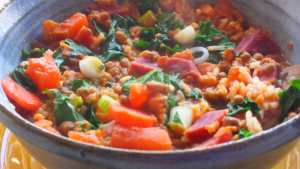 Kitchari is a traditional Ayurvedic dish that is nourishing, cleansing, and quite versatile. I am calling this particular kitchari recipe my “Christmas Kitchari” not only because it is a healthy meal option for the winter months, but also because this warming dish provides a beautiful array of red and green colors, perfect for the holiday season!
Kitchari is a traditional Ayurvedic dish that is nourishing, cleansing, and quite versatile. I am calling this particular kitchari recipe my “Christmas Kitchari” not only because it is a healthy meal option for the winter months, but also because this warming dish provides a beautiful array of red and green colors, perfect for the holiday season!
During this time of potlucks, parties, and Christmas cookies, this recipe could be a much needed addition to your regular meal routine to allow your digestion to rest, while flushing out some accumulated toxins. Of course this dish can be made any time of year; however, it is most recommended during the fall and winter months to keep seasonal with the vegetable selection.
Health Benefits of Christmas Kitchari
- Cleanses the blood and GI tract
- Gentle on the digestion
- Beneficial during times of toxic build-up, low digestive fire, and illness
- Filled with iron and other blood building nutrients (great for anemia!)
- Loaded with fiber, vitamins, and minerals (especially vitamins A,B, C, K)
- Plant based, complete protein source
- Warming recipe, perfect for the fall and winter months
- Grounding recipe to reduce Vata dosha
- Suitable for all body types with recommended modifications
Christmas Kitchari Recipe
Click here for a printable copy of this recipe.
- Doshic effect: Vata ↓, Pitta ↓*, Kapha ↓*
- Vegan, Vegetarian
- Gluten-Free
- Serves: 3 to 4
- Prep Time: 10 minutes
- Cooking Time: 55 minutes
*Please follow the Pitta and Kapha modifications listed below the recipe.
Materials
- Large sauce pan
- Cutting board and knife
- Ginger grater (optional)
Ingredients
- 1 tablespoon of sesame oil (use coconut oil for Pitta)
- 1/2 teaspoon cumin seed, whole
- 1/2 teaspoon brown mustard seed, whole
- 1/3 cup minced onion
- 1 to 2 teaspoons Agni Churna spice blend
- Fresh ginger (1 inch cube), peeled and finely grated
- Pinch of cayenne pepper (optional, omit for Pitta)
- 7 cups of water (substitute veggie or chicken stock more flavor!)
- 1 cup of whole mung beans, soaked overnight*
- 1 cinnamon stick (omit for Pitta)
- 1 medium beet, peeled and chopped into tiny cubes
- 1 medium parsnip, peeled and chopped
- 1 medium carrot, chopped into thin slices
- 1 cup of basmati rice (use quinoa or millet for Kapha)
- 4 large kale leafs
- 1/3 cup chopped cilantro (plus extra for garnish)
- 3 green onions, chopped (plus extra for garnish)
- 1/2 lemon, juiced
- 3/4 teaspoon pink salt or mineral salt
- 1/8 teaspoon freshly ground black pepper
- Ghee, for individual servings (1 teaspoon per bowl)
*Soak 1 cup of mung beans in 4 cups of water overnight. Discard the water upon usage.
Directions
1. Add the oil to a large sauce pan and place on the stove over medium heat. Once warm, add the cumin seed, brown mustard seed, and minced onion. Sauté for 2 minutes stirring frequently. Add in the Agni Churna, fresh ginger, and cayenne pepper (if used). Sauté for 30 seconds, stirring constantly to avoid burning.
2. Add 7 cups of water to the same pan, increase the heat to high and cover until it comes to a boil. While you are waiting for the water to boil, chop up the beet, parsnip, and carrot.
3. Once boiling, reduce the heat to medium and add the mung beans, cinnamon stick, chopped beet, parsnip, and carrot. Cover only half way to prevent an overflow and cook for 30 minutes. Stir every 10 minutes.
4. While this is cooking begin to chop up the kale, green onion, and cilantro.
5. After 30 minutes, add the basmati rice (or other grain of choice) and kale. Reduce the heat to low and cook for an additional 20 minutes. Stir every 5 minutes.
6. After the 20 minutes, remove the pan from the heat. Add in the chopped cilantro and green onion, fresh squeezed lemon juice, salt, and pepper. Stir thoroughly.
7. Serve and enjoy this beautiful red and green dish in your favorite bowl. Garnish each bowl with extra cilantro, green onion, and 1 teaspoon of ghee. Add more salt and pepper if needed.
8. Sit, share, and nourish on a cool fall or winter’s day!
Click here for a printable copy of this recipe.
Optional Doshic Variations
Vata:
For Vata types, make sure to cook all of the veggies until they are very soft and the dish as a whole is quite mushy. Meat or bone broth is always a great base option for nourishing Vata (for non-vegetarians), but is not required.
Pitta:
For Pitta constitutions, omit the cayenne pepper and cinnamon stick, and replace the lemon with lime. Replace the sesame oil with coconut oil and add extra cilantro if desired.
Kapha:
For Kapha constitutions, keep the salt and oil to a minimum. Replace the cup of basmati rice with 1/2 cup of quinoa or millet, while increasing the amount of kale to 6 leafs. Extra ginger, cumin, brown mustard seed, and black pepper can be used, and increase the lemon to 1 whole lemon. Omit the teaspoon of ghee recommended when garnishing your dish.
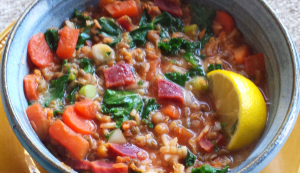
Find Your Kitchari Necessities here!
Discover more healing recipes with my 30-Minute Ayurvedic Cookbook!
Click here to see our full apothecary menu.

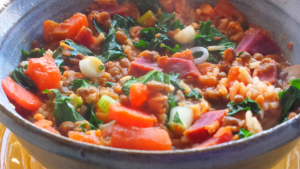

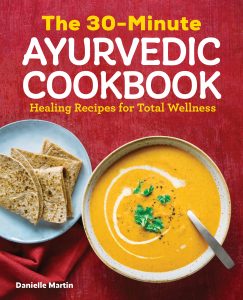
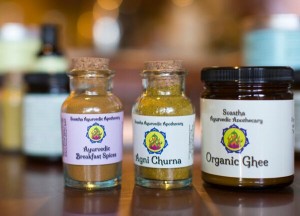

Cannot wait to try this with the beets and kale. Yum.
Hi Iona! I hope you enjoy the recipe and it helps get you into the holiday spirit:) Namaste, Danielle